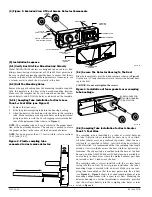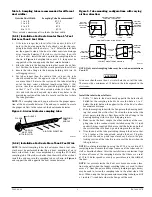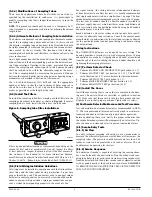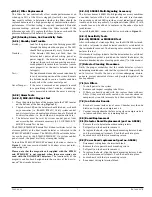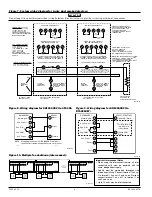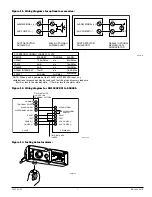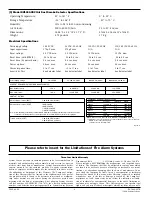
[5.4.3] Modifications of Sampling Tubes
There may be applications where duct widths are not what is
specified for the installation. In such cases, it is permissible to
modify a sampling tube that is longer than necessary to span the
duct width.
NOTE:
This procedure should only be used as a temporary fix. It
is not intended as a permanent substitute for ordering the correct
length tubes.
[5.4.4] Alternate Method of Sampling Tube Installation
The detector arrangement can also incorporate the remote mount-
ing of the sampling tube and/or exhaust tube. In this case both
the detector, sampling tube and exhaust tube (if included) should
be rigidly mounted to withstand the pressure and resonant vibra-
tions caused by the air velocity. The location of the detector’s
sampling tube should be such that there is uniform airflow in the
cross section area.
An air tight connection shall be made between the sampling tube,
exhaust tube and their corresponding ports on the detector hous-
ing. Upon selection of location in the system, pressure differential
across the sampling and exhaust ports in the detector housing
shall be verified to be within the allowable range of the detec-
tor. This is accomplished by measuring the pressure difference
between the inlet and outlet ports on the detector housing using a
manometer as described in Section 6 of this manual.
Use a 0.193-inch diameter (#11) drill and add the appropriate
number of holes so that the total number of holes exposed to
the air flow in the duct is 10 to 12. Space the additional holes as
evenly as possible over the length of the tube.
[5.5] Install The Filters
To install the sampling tube filters, simply push the filters into the
sampling and exhaust tube holes, as shown in
Figure 6
. If a metal
sampling tube is used, install the filters over the tube ends.
Figure 6. Sampling tube filter installation:
CAUTION
Filters require periodic cleaning or replacement, depending on the
amount of dust and dirt accumulated. Visually inspect the filters
at least quarterly; inspect them more often if the dust accumula-
tion warrants it. See Section [6] for more information. Replace-
ment filters can be ordered from System Sensor, 3825 Ohio Ave., St.
Charles, IL 60174. (Exhaust tube/intake tube filter P/N F36-09-11).
[5.6] Field Wiring Installation Guidelines
All wiring must be installed in compliance with the National Elec-
trical Code and the local codes having jurisdiction. Proper wire
gauges should be used. The conductors used to connect smoke
detectors to control panels and accessory devices should be color-
coded to prevent wiring mistakes. Improper connections can pre-
vent a system from responding properly in the event of a fire.
For signal wiring, (the wiring between interconnected detectors
or from detectors to auxiliary devices), it is usually recommended
that single conductor wire be no smaller than 18 gauge. The duct
smoke detector terminals accommodate wire sizes up to 12 gauge.
The last foot of conduit should be flexible conduit (available in
electrical supply houses), which facilitates easier installation and
puts less strain on the conduit holes in the housing. Solid conduit
connections may be used if desired.
Smoke detectors and alarm system control panels have specifi-
cations for allowable loop resistance. Consult the control panel
manufacturer’s specifications for the total loop resistance allowed
for the particular model control panel being used before wiring
the detector loop.
Wiring Instructions
The DH100ACDCI detectors are designed for easy wiring. The
housing provides a terminal strip with clamping plates. Wiring
connections are made by stripping about 3⁄8-inch of insulation
from the end of the wire, sliding the bare end under the plate, and
tightening the clamping plate screw.
[5.7] Perform Detector Check
1. Perform STANDBY AND TROUBLE TEST per Section [6.2.1].
2. Perform MAGNET TEST per Section [6.2.2.1]. The RTS451
test of Section [6.2.2.2] may substitute for this requirement.
3. Perform AIR FLOW TEST per Section [6.1.1].
4. Perform SMOKE RESPONSE TEST per Section [6.1.2].
5. Perform SENSITIVITY TEST per Section [6.2.3].
[5.8] Install The Cover
Install the cover using the six screws that are captured in the hous-
ing cover. Be certain filters are installed as specified in Section
[5.5]. Make sure that the cover fits into the base groove and that
all gaskets are in their proper positions. Tighten the six screws.
[6] Duct Smoke Detector Maintenance And Test Procedures
Test and maintain duct smoke detectors as recommended in NFPA
72. The tests contained in this manual were devised to assist main-
tenance personnel in verification of proper detector operation.
Before conducting these tests, notify the proper authorities that
the smoke detection system will be temporarily out of service. Dis-
able the zone or system under test to prevent unwanted alarms.
[6.1] Smoke Entry Tests
[6.1.1] Air Flow
To verify sufficient sampling of ducted air, use a manometer to
measure the differential pressure created from air flow across the
sampling tubes. The pressure should measure no less than 0.03
inches of water and no greater than 1.4 inches of water. The air
handler must be operating for this test.
[6.1.2] Smoke Response
To determine if smoke is capable of entering the sensing cham-
ber, visually identify any obstructions. Plug the exhaust and sam-
pling tube holes to prevent ducted air from carrying smoke away
from the detector head, then blow smoke such as cigarette, cotton
wick, or punk directly at the head to cause an alarm. REMEMBER
TO REMOVE THE PLUGS AFTER THIS TEST, OR THE DETECTOR
WILL NOT FUNCTION PROPERLY.
D100-68-00
4
I56-1684-007R
H0400-00


